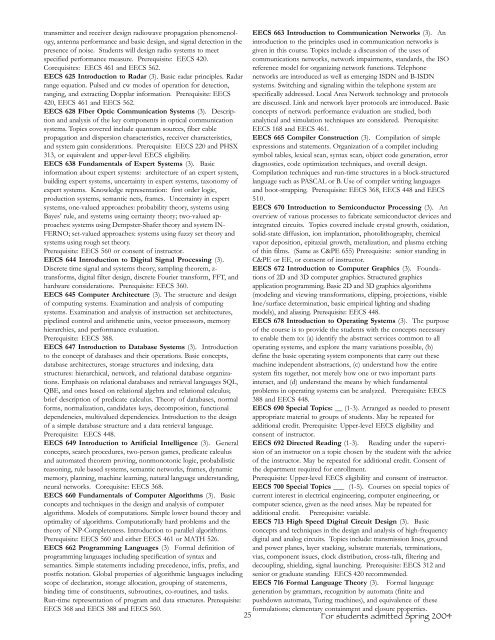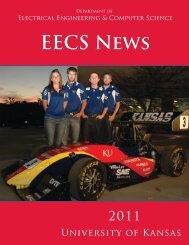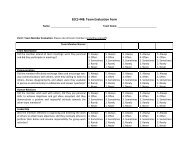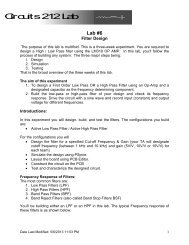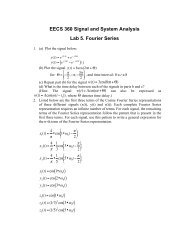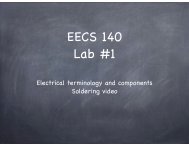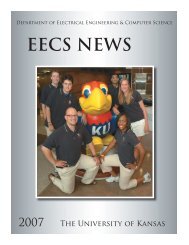Spring 2004 Handbook - Electrical Engineering and Computer ...
Spring 2004 Handbook - Electrical Engineering and Computer ...
Spring 2004 Handbook - Electrical Engineering and Computer ...
You also want an ePaper? Increase the reach of your titles
YUMPU automatically turns print PDFs into web optimized ePapers that Google loves.
transmitter <strong>and</strong> receiver design radiowave propagation phenomenology,antenna performance <strong>and</strong> basic design, <strong>and</strong> signal detection in thepresence of noise. Students will design radio systems to meetspecified performance measure. Prerequisite: EECS 420.Corequisites: EECS 461 <strong>and</strong> EECS 562.EECS 625 Introduction to Radar (3). Basic radar principles. Radarrange equation. Pulsed <strong>and</strong> cw modes of operation for detection,ranging, <strong>and</strong> extracting Dopplar information. Prerequisite: EECS420, EECS 461 <strong>and</strong> EECS 562.EECS 628 Fiber Optic Communication Systems (3). Description<strong>and</strong> analysis of the key components in optical communicationsystems. Topics covered include quantum sources, fiber cablepropagation <strong>and</strong> dispersion characteristics, receiver characteristics,<strong>and</strong> system gain considerations. Prerequisite: EECS 220 <strong>and</strong> PHSX313, or equivalent <strong>and</strong> upper-level EECS eligibility.EECS 638 Fundamentals of Expert Systems (3). Basicinformation about expert systems: architecture of an expert system,building expert systems, uncertainty in expert systems, taxonomy ofexpert systems. Knowledge representation: first order logic,production systems, semantic nets, frames. Uncertainty in expertsystems, one-valued approaches: probability theory, systems usingBayes’ rule, <strong>and</strong> systems using certainty theory; two-valued approaches:systems using Dempster-Shafer theory <strong>and</strong> system IN-FERNO; set-valued approaches: systems using fuzzy set theory <strong>and</strong>systems using rough set theory.Prerequisite: EECS 560 or consent of instructor.EECS 644 Introduction to Digital Signal Processing (3).Discrete time signal <strong>and</strong> systems theory, sampling theorem, z-transforms, digital filter design, discrete Fourier transform, FFT, <strong>and</strong>hardware considerations. Prerequisite: EECS 360.EECS 645 <strong>Computer</strong> Architecture (3). The structure <strong>and</strong> designof computing systems. Examination <strong>and</strong> analysis of computingsystems. Examination <strong>and</strong> analysis of instruction set architectures,pipelined control <strong>and</strong> arithmetic units, vector processors, memoryhierarchies, <strong>and</strong> performance evaluation.Prerequisite: EECS 388.EECS 647 Introduction to Database Systems (3). Introductionto the concept of databases <strong>and</strong> their operations. Basic concepts,database architectures, storage structures <strong>and</strong> indexing, datastructures: hierarchical, network, <strong>and</strong> relational database organizations.Emphasis on relational databases <strong>and</strong> retrieval languages SQL,QBE, <strong>and</strong> ones based on relational algebra <strong>and</strong> relational calculus;brief description of predicate calculus. Theory of databases, normalforms, normalization, c<strong>and</strong>idates keys, decomposition, functionaldependencies, multivalued dependencies. Introduction to the designof a simple database structure <strong>and</strong> a data retrieval language.Prerequisite: EECS 448.EECS 649 Introduction to Artificial Intelligence (3). Generalconcepts, search procedures, two-person games, predicate calculus<strong>and</strong> automated theorem proving, nonmonotonic logic, probabilisticreasoning, rule based systems, semantic networks, frames, dynamicmemory, planning, machine learning, natural language underst<strong>and</strong>ing,neural networks. Corequisite: EECS 368.EECS 660 Fundamentals of <strong>Computer</strong> Algorithms (3). Basicconcepts <strong>and</strong> techniques in the design <strong>and</strong> analysis of computeralgorithms. Models of computations. Simple lower bound theory <strong>and</strong>optimality of algorithms. Computationally hard problems <strong>and</strong> thetheory of NP-Completeness. Introduction to parallel algorithms.Prerequisite: EECS 560 <strong>and</strong> either EECS 461 or MATH 526.EECS 662 Programming Languages (3) Formal definition ofprogramming languages including specification of syntax <strong>and</strong>semantics. Simple statements including precedence, infix, prefix, <strong>and</strong>postfix notation. Global properties of algorithmic languages includingscope of declaration, storage allocation, grouping of statements,binding time of constituents, subroutines, co-routines, <strong>and</strong> tasks.Run-time representation of program <strong>and</strong> data structures. Prerequisite:EECS 368 <strong>and</strong> EECS 388 <strong>and</strong> EECS 560.EECS 663 Introduction to Communication Networks (3). Anintroduction to the principles used in communication networks isgiven in this course. Topics include a discussion of the uses ofcommunications networks, network impairments, st<strong>and</strong>ards, the ISOreference model for organizing network functions. Telephonenetworks are introduced as well as emerging ISDN <strong>and</strong> B-ISDNsystems. Switching <strong>and</strong> signaling within the telephone system arespecifically addressed. Local Area Network technology <strong>and</strong> protocolsare discussed. Link <strong>and</strong> network layer protocols are introduced. Basicconcepts of network performance evaluation are studied, bothanalytical <strong>and</strong> simulation techniques are considered. Prerequisite:EECS 168 <strong>and</strong> EECS 461.EECS 665 Compiler Construction (3). Compilation of simpleexpressions <strong>and</strong> statements. Organization of a compiler includingsymbol tables, lexical scan, syntax scan, object code generation, errordiagnostics, code optimization techniques, <strong>and</strong> overall design.Compilation techniques <strong>and</strong> run-time structures in a block-structuredlanguage such as PASCAL or B. Use of compiler writing languages<strong>and</strong> boot-strapping. Prerequisite: EECS 368, EECS 448 <strong>and</strong> EECS510.EECS 670 Introduction to Semiconductor Processing (3). Anoverview of various processes to fabricate semiconductor devices <strong>and</strong>integrated circuits. Topics covered include crystal growth, oxidation,solid-state diffusion, ion implantation, photolithography, chemicalvapor deposition, epitaxial growth, metalization, <strong>and</strong> plasma etchingof thin films. (Same as C&PE 655) Prerequisite: senior st<strong>and</strong>ing inC&PE or EE, or consent of instructor.EECS 672 Introduction to <strong>Computer</strong> Graphics (3). Foundationsof 2D <strong>and</strong> 3D computer graphics. Structured graphicsapplication programming. Basic 2D <strong>and</strong> 3D graphics algorithms(modeling <strong>and</strong> viewing transformations, clipping, projections, visibleline/surface determination, basic empirical lighting <strong>and</strong> shadingmodels), <strong>and</strong> aliasing. Prerequisite: EECS 448.EECS 678 Introduction to Operating Systems (3). The purposeof the course is to provide the students with the concepts necessaryto enable them to: (a) identify the abstract services common to alloperating systems, <strong>and</strong> explore the many variations possible, (b)define the basic operating system components that carry out thesemachine independent abstractions, (c) underst<strong>and</strong> how the entiresystem fits together, not merely how one or two important partsinteract, <strong>and</strong> (d) underst<strong>and</strong> the means by which fundamentalproblems in operating systems can be analyzed. Prerequisite: EECS388 <strong>and</strong> EECS 448.EECS 690 Special Topics: __ (1-3). Arranged as needed to presentappropriate material to groups of students. May be repeated foradditional credit. Prerequisite: Upper-level EECS eligibility <strong>and</strong>consent of instructor.EECS 692 Directed Reading (1-3). Reading under the supervisionof an instructor on a topic chosen by the student with the adviceof the instructor. May be repeated for additional credit. Consent ofthe department required for enrollment.Prerequisite: Upper-level EECS eligibility <strong>and</strong> consent of instructor.EECS 700 Special Topics ___ (1-5). Courses on special topics ofcurrent interest in electrical engineering, computer engineering, orcomputer science, given as the need arises. May be repeated foradditional credit. Prerequisite: variable.EECS 713 High Speed Digital Circuit Design (3). Basicconcepts <strong>and</strong> techniques in the design <strong>and</strong> analysis of high-frequencydigital <strong>and</strong> analog circuits. Topics include: transmission lines, ground<strong>and</strong> power planes, layer stacking, substrate materials, terminations,vias, component issues, clock distribution, cross-talk, filtering <strong>and</strong>decoupling, shielding, signal launching. Prerequisite: EECS 312 <strong>and</strong>senior or graduate st<strong>and</strong>ing. EECS 420 recommended.EECS 716 Formal Language Theory (3). Formal languagegeneration by grammars, recognition by automata (finite <strong>and</strong>pushdown automata, Turing machines), <strong>and</strong> equivalence of theseformulations; elementary containment <strong>and</strong> closure properties.25 For students admitted <strong>Spring</strong> <strong>2004</strong>


